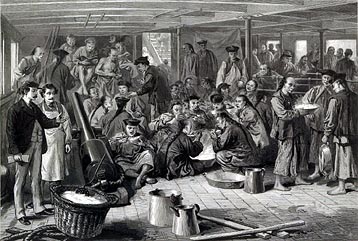










|
 |
| |
|

 |
Local and State Anti-Chinese Legislation |
Most immigrants from Asia arrived at the port of San Francisco. As soon as
they began arriving in substantial numbers during the 1850s, the Chinese were
targeted for discrimination in California. The local and state legislation
passed in San Francisco and California between 1850 and 1880 is indicative
of the strength of anti-Chinese feeling amongst West Coast Americans. This
activity lists some of the city and state laws that aimed to deter Chinese
immigration and restrict the lives of those who lived here. It also indicates
what happened to many of these pieces of legislation.

Chinese Emigration to America: sketch on board the steam-ship Alaska bound for San Francisco, 1876
We suggest this activity be done as a class discussion. Put the list of
local and state anti-Chinese legislation on an overhead projector. Cover
the column
of subsequent actions.

The following questions can be asked to help stimulate
students’ thinking about this information:
-
Why were the city of San Francisco and the state of California so concerned
with Chinese immigrants and workers?
-
Many of these laws are indirectly aimed at the Chinese by targeting items
used or ways of doing things that are considered typically Chinese—for
example, the use of a specific type of net for fishing. What other
items or customs are
attacked by anti-Chinese legislation?
-
Other laws make it clear that the Chinese were considered a separate
race that should be segregated from whites and kept in an inferior
position in society.
Which laws emphasize the Chinese as a separate race unworthy of
equal status with whites?
-
What are the repercussions of a law that says Chinese can not
testify in court against whites? Who would benefit from this
legislation?
-
Who would benefit from a Foreign Miners tax or from heavy taxes
on laundries that use carrying poles rather than carts?
-
How were the Chinese immigrants contributing to the economy
and the development of California and the United States?
Who benefited
from
their work?
-
Why are these laws considered discriminatory?
-
Do you think a city or state would pass or uphold laws or rules today
that are so clearly aimed at restricting a specific group of people in our
society?
-
How could California pass laws like these in the 1880’s and 90’s?
Do some of these conflict with the United States Constitution? What can
people do when unjust laws are enacted?
Uncover the column of subsequent actions. What inferences can the students
draw from this information?
Three main points should be emphasized from this legislative history:
-
The U.S. Constitution and the American legal system were able to offer
some protection from the xenophobia and anti-Chinese feeling that
were prevalent.
-
The Chinese American community quickly recognized how to use the courts
to counter the political and social hostility they experienced and
to actively respond
to unjust legislation.
-
Despite the fact that most of this legislation was quickly struck down
when challenged in court, the city council and state legislature
were determined to continue writing and passing anti-Chinese legislation.
This
sustained
effort
over five decades indicates the overwhelming anti-Chinese feeling
among the general
population and the popularity and support politicians gained by pursuing
these measures.
|
 |


|